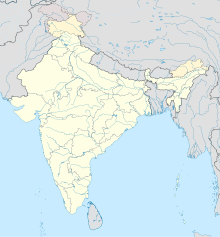Badami Cave Temples
| Badami cave temples | |
|---|---|

Vishnu image in Badami cave 3
|
|
| Location of the cave in India | |
| Location | Badami, Karnataka |
| Coordinates | 15°55′06″N 75°41′06″E / 15.91833°N 75.68500°ECoordinates: 15°55′06″N 75°41′06″E / 15.91833°N 75.68500°E |
| Discovery | 6th Century |
| Geology | Sandstone |
| Entrances | Six caves |
| Difficulty | Easy |
| Features | UNESCO world heritage site candidate |
The Badami cave temples are a complex of four Hindu, Jain and possibly Buddhist cave temples located in Badami, a town in the Bagalkot district in northern part of Karnataka, India. The caves are considered an example of Indian rock-cut architecture, especially Badami Chalukya architecture, which dates from the 6th century. Badami was previously known as Vataapi Badami, the capital of the early Chalukya dynasty, which ruled much of Karnataka from the 6th to the 8th century. Badami is situated on the west bank of an artificial lake ringed by an earthen wall with stone steps; it is surrounded on the north and south by forts built in later times.
The Badami cave temples represent some of the earliest known examples of Hindu temples. UNESCO has described the designs of the Badami cave temples, and those in Aihole, as having transformed the Malaprabha River valley into a cradle of temple architecture that defined the components of later Hindu temples elsewhere in India.
Caves 1 to 4 are in the escarpment of the hill in soft Badami sandstone formation, to the south-east of the town. In Cave 1, among various sculptures of Hindu divinities and themes, a prominent carving is of the Tandava-dancing Shiva as Nataraja. Cave 2 is mostly similar to Cave 1 in terms of its layout and dimensions, featuring Hindu subjects of which the relief of Vishnu as Trivikrama is the largest. The largest cave is Cave 3, featuring Vishnu-related mythology, and it is also the most intricately carved cave in the complex. Cave 4 is dedicated to revered figures of Jainism. Cave 5 may be a Buddhist cave. Another cave was discovered in 2015, about 500 metres (1,600 ft) from the four main caves, with 27 Hindu carvings.
...
Wikipedia

